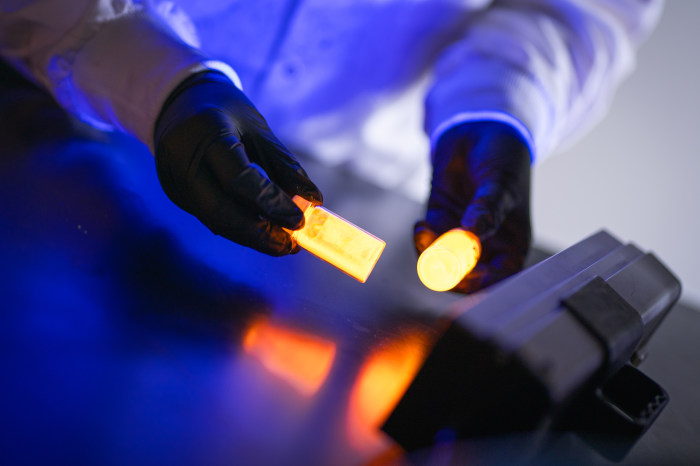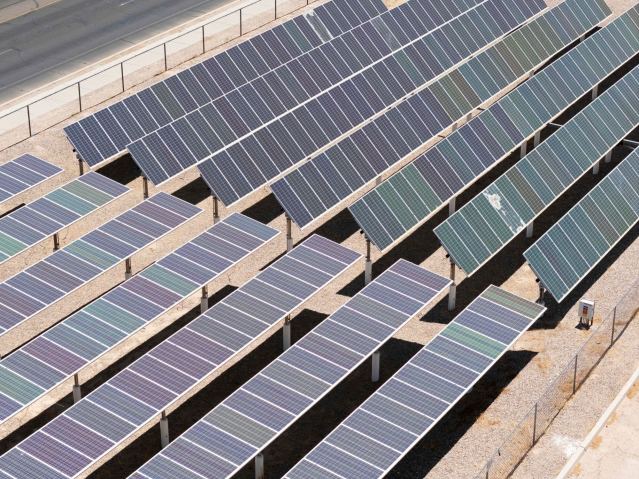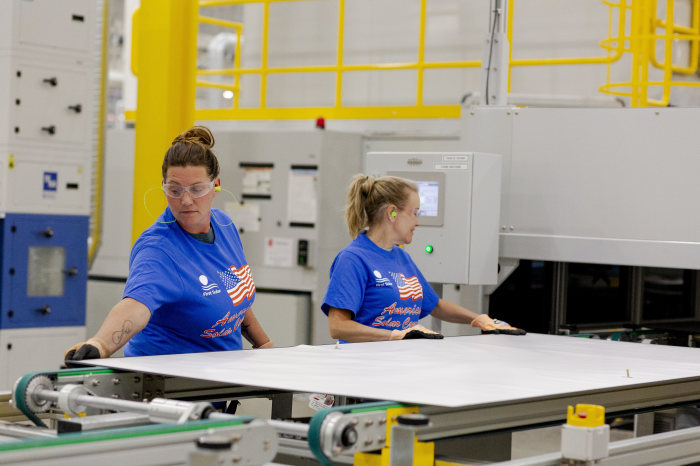More
Supercharging Solar With Quantum Dots
Nanotechnology is making waves in the clean-tech space—and could give the U.S. a rare lead over China in photovoltaic innovation

Quantum dots measure just a few nanometers in size. That’s 10,000 times thinner than a human hair. Often described as man-made atoms, these nanocrystals have been illuminating television screens for a decade. Now they could be about to light up the U.S. solar industry.
Arizona-based solar-tech company First Solar on Wednesday unveiled a long-term commercial partnership with New Mexico-based advanced-materials company UbiQD, to accelerate the integration of quantum dots into its solar panels. The deal marks the biggest move yet to scale the technology within the U.S. renewables sector.
Quantum dots are microscopic spheres of semiconductor material that could potentially double the efficiency of devices converting sunlight into energy, according to the U.S. Energy Department’s National Renewable Energy Laboratory. The next-generation solar technology captures a wider spectrum of sunlight than traditional panels, using what is known as the quantum confinement effect—essentially wringing more energy out of each photon.
Researchers have long theorized on the potential of quantum dots for the energy transition. To date their most common commercial use has been in televisions, allowing for more vibrant and lifelike colors. The Q in QLED, seen on many of today’s TVs, stands for quantum dot. In 2023, a trio of scientists won the Nobel Prize in chemistry for bringing decades of theory on quantum dots into practice, paving the way for their mass production.

While quantum dots alone aren’t currently advanced enough to replace regular silicon-based solar panels, the industry is now using the technology in tandem with more traditional hardware to boost efficiency, said Dmitri Talapin, a professor of chemistry at the University of Chicago.
“The beauty of quantum dots is that they can be manufactured extremely inexpensively and applied like paint to silicone modules to improve efficiency,” he said.
After several years of lab testing, First Solar will begin adding a layer of UbiQD’s quantum dots to its thin film bifacial solar panels, with a commercial rollout set for late 2026. The dots will initially be used on the underside of each panel, where they will help to capture light bouncing off the ground (on the top side, light is already captured efficiently by the existing cells). In some cases, the dots can more than double the efficiency of this side of the panel, according to Hunter McDaniel, founder and CEO of UbiQD.
“At utility-scale, even incremental gains in bifaciality translate into significant real-world impact on energy yield,” said Markus Gloeckler, chief technology officer at First Solar. “We’re excited about the potential for quantum dot technology to contribute meaningful gains to the performance of our bifacial modules.”
As part of the deal, UbiQD, which is based in Los Alamos, N.M., said it plans to develop “one of the world’s highest-volume quantum dot manufacturing facilities” in the U.S. within the next year.

The move comes at a tough moment for the U.S. solar industry as renewable companies are feeling the pinch under the Trump administration. First Solar was a beneficiary of Biden’s Inflation Reduction Act, but now stands in more precarious territory amid a shift to climate-skeptical and protectionist policy. The company recently trimmed earnings guidance and forecast significant write-downs on its overseas facilities.
But the deal highlights a rare lead for U.S. clean-tech innovation against the dominance of China.
“The U.S. is exploring technologies that can put them ahead of the curve,” University of Chicago’s Talapin said, adding that China’s lead in traditional solar technologies has hastened the need for innovation in the West.
Still, in addition to an unfavorable policy environment, quantum dots face several other challenges as a solar technology. For one, being able to translate lab-tested efficiencies to the mass market.
“There are a lot of companies that have made solar cells in the lab with very, very high efficiencies. But that’s very different from being tested in a real-life setting,” said Jenny Chase, a solar analyst at BloombergNEF.
In this respect, quantum dots lag behind other next-generation solar technologies such as perovskite solar cells, which have a crystal structure and are known for high levels of efficiency and low production costs. Oxford PV, for example, already supplied a utility-scale perovskite solar project in the U.S. in late 2024. The spinout of Oxford University has said its panels can produce up to 20% more energy compared with traditional ones. China is also dominant in the commercialization of perovskite technologies.
Meanwhile, quantum dots have come up against their own sustainability concerns.
“The first generation of quantum dots used heavy metals like cadmium and lead, which came with many toxicity concerns,” Talapin said, noting that materials could leak into groundwaters after rain and damage to solar cells.
UbiQD said its dots—developed in collaboration with the Energy Department’s Los Alamos National Laboratory and the Massachusetts Institute of Technology—swap out cadmium for a nontoxic combination of copper and indium.
The switch made the technology more sustainable, meaning greater scalability across industries and regions, said UbiQD’s McDaniel. In the First Solar deal alone, McDaniel expects annual demand for quantum dots of more than 100 metric tons, outpacing the global display industry, which currently accounts for around 40 tons, he said.
“Quantum dots aren’t going to be thought of as a display technology for much longer,” he said. “They’re going to be thought of as a solar technology.”
Write to Don Nico Forbes at don.forbes@wsj.com
Appeared in the July 10, 2025, print edition as 'U.S. Producer of Solar Panels Powers Up With Quantum Dots'.

